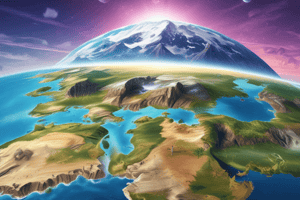Podcast
Questions and Answers
What is the equator?
What is the equator?
- An imaginary line that marks the boundary of the polar zone
- An imaginary line indicating the North Pole
- An imaginary line around the Earth at 0° (correct)
- An imaginary line of longitude at 180°
What is the prime meridian?
What is the prime meridian?
An imaginary line of longitude marked at 0°
What does the International Date Line correspond to?
What does the International Date Line correspond to?
180° longitude
At what latitude is the Tropic of Cancer located?
At what latitude is the Tropic of Cancer located?
What is the Tropic of Capricorn?
What is the Tropic of Capricorn?
What is the Arctic Circle?
What is the Arctic Circle?
What is the Antarctic Circle?
What is the Antarctic Circle?
What are parallel lines?
What are parallel lines?
What are meridian lines?
What are meridian lines?
Where is the North Pole?
Where is the North Pole?
Where is the South Pole?
Where is the South Pole?
Flashcards are hidden until you start studying
Study Notes
Equator
- Imaginary line located at 0° latitude.
- Divides the Earth into Northern and Southern Hemispheres.
- Serves as a reference point for measuring latitude.
Prime Meridian
- Imaginary line marked at 0° longitude.
- Divides the Earth into Eastern and Western Hemispheres.
- Acts as the starting point for measuring time zones.
International Date Line
- Roughly aligned with 180° longitude in the Pacific Ocean.
- Separates calendar days; east is one day earlier than west.
- Facilitates international timekeeping and date changes.
Tropic of Cancer
- Located at 23.5°N latitude.
- Marks the northernmost point where the sun's rays are directly overhead.
- Defines the northern limit of the tropical zone.
Tropic of Capricorn
- Situated at 23.5°S latitude.
- Indicates the southernmost point where the sun's rays are directly overhead.
- Represents the southern limit of the tropical zone.
Arctic Circle
- Latitude line located at 60°N.
- Designates the boundary of the northern polar zone.
- Where at least one day of the year has 24 hours of continuous daylight or darkness.
Antarctic Circle
- Latitude line located at 60°S.
- Defines the boundary of the southern polar zone.
- Similar to the Arctic, experiences extreme variations in daylight.
Parallel Lines
- Imaginary lines running parallel to the Equator.
- Serve as indicators for various climate zones, such as polar and tropical regions.
- Latitude lines have consistent distances apart.
Meridian Lines
- Imaginary lines stretching between the North and South Poles.
- Cross the Equator at right angles and measure longitude.
- Time zones are based on these lines, with each line equating to one hour difference from the Prime Meridian.
North Pole
- Point located at 90°N, the northern end of Earth's axis of rotation.
- Positioned in the Arctic Ocean.
- Often associated with polar conditions and ice cap.
South Pole
- Point located at 90°S, the southern end of Earth's axis of rotation.
- Located in Antarctica, a remote and icy region.
- Represents the geographic southernmost point on Earth.
Studying That Suits You
Use AI to generate personalized quizzes and flashcards to suit your learning preferences.




